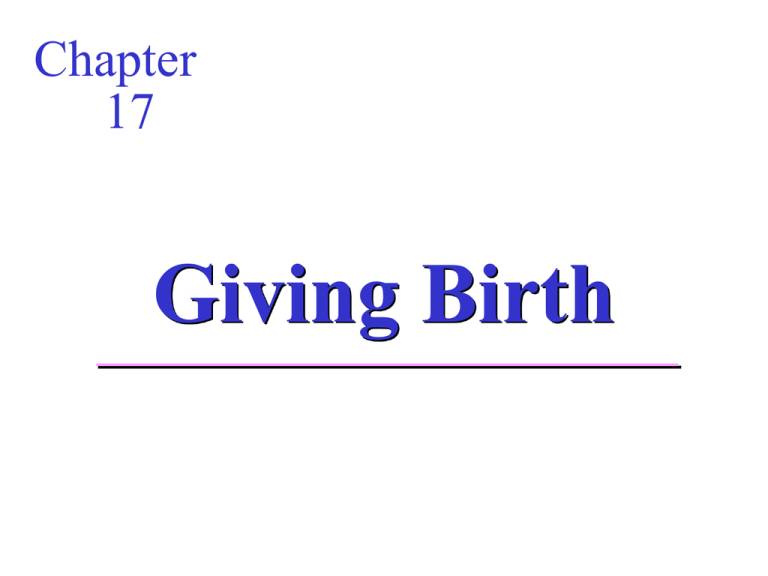
Chapter
17
Giving Birth
Copyright © 2005 by Elsevier, Inc. All rights reserved.
Physiologic Effect of the
Birth Process
• Maternal Responses:
Significant changes occurs in
woman’s body system related
to effect of birth process
Copyright © 2005 by Elsevier, Inc. All rights reserved.
Cardiovascular system:
During contraction, blood flow to
the placenta gradually
decreases, causing a relative
increase in the woman blood
volume which slightly increase
the blood pressure and slow the
pulse.
Copyright © 2005 by Elsevier, Inc. All rights reserved.
Respiratory system:
Increase depth and rate of respiration
especially if the mother is anxious
or in pain.
The woman may experience
hyperventilation (tingling in her
hands and feet, numbness,
dizziness)
Helping her to slow her breathing and
to breath into a paper bag or her
cupped hands to decrease these
symptoms
Copyright © 2005 by Elsevier, Inc. All rights reserved.
Gastrointestinal system:
- Decrease gastric motility
- Not hungry but thirsty and dry
mouth
- Reduce food and large amount of
fluids to reduce risk of vomiting and
aspiration.
- Ice chips and clear liquid can be
given or hard candy
- Large amount of sugar is not
recommended it leads to neonatal
hypoglycemia after birth
Copyright © 2005 by Elsevier, Inc. All rights reserved.
Hematopoitic system:
- 500 ml is maximum blood loss during
vaginal birth
- Increase in WBCs 14,000- 16,000mm³
in average and may reach 25,000 /mm
- Fibrinogen and clotting factors
increase during labor and after birth
- Decrease Fibrinolysis (clot
breakdown) to prevent hemorrhage
Copyright © 2005 by Elsevier, Inc. All rights reserved.
Urinary System
Decreased sensation to full
bladder
Full bladder prevent decent
and lead to discomfort
Copyright © 2005 by Elsevier, Inc. All rights reserved.
Reproductive system:
Normal labor contractions are:
- Coordinated
- Involuntary
- Intermittent
- Contraction cycle
- 1. Increment: begins as the contraction starts
in the uterus
- 2. Peak(Acme): period during which
contraction is most intense
- 3. Decrement: the period of decreasing
intensity as uterus relax
Copyright © 2005 by Elsevier, Inc. All rights reserved.
Characteristics of the
contraction:
- Frequency: it is the period from
the beginning of one uterine
contraction to the beginning of the
next, expressed in minute and
fractions of minute
- Duration: the length of each
contraction from the beginning to
the end,expressed in seconds
- Intensity: the strength of the
contraction (mild, moderate, strong)
Copyright © 2005 by Elsevier, Inc. All rights reserved.
- Mild contraction like feeling the
tip of the nose
- Moderate contractions like the
chin
- Strong contraction like the
forhead
- Interval: the period from the end
of one contraction to the beginning
of the next
Copyright © 2005 by Elsevier, Inc. All rights reserved.
Uterine body:
- The upper two third 2/3 of the
uterus contracts actively to push the
fetus down, and it becomes thicker
- The lower third remain less active
(passive) allowing downward
passage of the fetus, and it becomes
thinner
- The cervix is also passive.
- The opposing characteristics of the
contractions in the upper and lower
uterine segment change the shape of
uterine cavity to become more
elongated and narrower which
straighten the fetal body and directs
Copyright © 2005 by Elsevier, Inc. All rights reserved.
Uterine Contractions:
Opposing Characteristics
Fig. 17-2
Copyright © 2005 by Elsevier, Inc. All rights reserved.
Cervical changes:
- Effacement: (thinning and
shortening) fully thinned cervix
is 100% effaced.
- Dilation: opening of cervix. Full
dilation is 10cm.
Copyright © 2005 by Elsevier, Inc. All rights reserved.
Cervical Dilation and
Effacement
Copyright © 2005 by Elsevier, Inc. All rights reserved.
Copyright © 2005 by Elsevier, Inc. All rights reserved.
Copyright © 2005 by Elsevier, Inc. All rights reserved.
- Fetal response
Placental circulation
During strong contraction , the blood
supply to the placenta stops
intermittently ,therefore most
placental blood exchange occurs
during intervals between
contractions
Fetus has a protective mechanism
such as a high hemoglobin,
hematocrite and cardiac output
Copyright © 2005 by Elsevier, Inc. All rights reserved.
Cardiovascular system: higher
heart rate 110-160
Pulmonary: labor intensifies
absorption of lung fluid and
some fluid expressed from upper
air way as fetus pass birth canal
Copyright © 2005 by Elsevier, Inc. All rights reserved.
Components of the
Birth Process(4 P,s)
• Powers
• Passage
• Passenger
• Psyche
Copyright © 2005 by Elsevier, Inc. All rights reserved.
1. Power
a.Uterine contractions:
Involuntary, primary power
b.Pushing
efforts(Bearing down
effort), Secondary Power
Copyright © 2005 by Elsevier, Inc. All rights reserved.
2.Passage:
Maternal pelvis and soft
tissues
true pelvis
2. false pelvis
Bony pelvis: 1.
True pelvis has three parts
1. Inlet: upper pelvic
opening
2.
midpelvis: pelvic cavity
3. outlet: lower pelvic
opening
Copyright © 2005 by Elsevier, Inc. All rights reserved.
3.Passenger
The passenger is the fetus plus
the membranes and placenta.
Fetal head: the fetus enters the
birth canal in the cephalic
presentation 96% of the time.
1. Bones, sutures and fontanels
Copyright © 2005 by Elsevier, Inc. All rights reserved.
Fetal Head: Bones, Sutures, Fontanels
Fig. 17-5a
Copyright © 2005 by Elsevier, Inc. All rights reserved.
2. Fetal head diameters:
Biparietal diameter 9.5 cm,
Anteroposterior diameter
Suboccipitobregmatic diameter 9.5 cm
Occipitofrontal diameter 11 cm
Supraoccipitomental diameter 13.5 cm
Submentobregmatic diameter 9.5 cm
Copyright © 2005 by Elsevier, Inc. All rights reserved.
Variations in the passenger:
1.Fetal lie
2.Attitude
3.Presentation
4.position
Copyright © 2005 by Elsevier, Inc. All rights reserved.
1. Fetal
lie: it is the orientation
of the long axis of the fetus to
the long axis of the woman.
a. Longitudinal lie
b. Transverse lie
c. Oblique lie
Copyright © 2005 by Elsevier, Inc. All rights reserved.
Copyright © 2005 by Elsevier, Inc. All rights reserved.
2. Attitude: the attitude of the
-
fetus is the relation of fetal body
parts to each others.
The normal fetal attitude is
(flexion),
Head flexed toward the chest,
Arms and legs flexed over the
thorax,
Back curved C shape.
Copyright © 2005 by Elsevier, Inc. All rights reserved.
Copyright © 2005 by Elsevier, Inc. All rights reserved.
3. presentation: the fetal part
that enters the pelvis part is the
presenting part.
- Cephalic presentation (head)
- Breech presentation(buttock)
- Shoulder presentation(scapula)
a. Cephalic presentation: it is the
most common with the fetal head
flexed.
Copyright © 2005 by Elsevier, Inc. All rights reserved.
Types of Cephalic Presentation:
Vertex and Military
Copyright © 2005 by Elsevier, Inc. All rights reserved.
Types of Cephalic Presentation:
Brow and Face
Copyright © 2005 by Elsevier, Inc. All rights reserved.
Variations of Cephalic
presentation
• Vertex: fetal head fully flexed most
preferable for normal
labor(suboccipito pregmatic
diameter)
• Military: head in neutral position
,neither flexed or
extend(occipitofrontal diameter)
• Brow: fetal head is partially
extend(supraoccipito mental
diameter)
• Face: Face fully extended(sub
mentobregmatic diameter)
Copyright © 2005 by Elsevier, Inc. All rights reserved.
b. Breech presentation:
Disadvantages:
1. The buttocks are not smooth and firm
like the head and are less effective in
dilating the cervix.
2. The fetal head is the last part to be born,
so the umbilical cord is subject to
compression.
3. Gradual molding is not permit, Because
the umbilical cord can be compressed after
the fetal chest is born, the head must be
delivered quickly to allow infant to breath.
Copyright © 2005 by Elsevier, Inc. All rights reserved.
Breech presentation
variations
• Frank breech
• Full or complete
breech
• Footling breech
Copyright © 2005 by Elsevier, Inc. All rights reserved.
Variations of a Breech
Presentation
Copyright © 2005 by Elsevier, Inc. All rights reserved.
Copyright © 2005 by Elsevier, Inc. All rights reserved.
Copyright © 2005 by Elsevier, Inc. All rights reserved.
4. Position:
Fetal position describes the location of a fixed
reference point on the presenting part in
relation to the four quadrants of the maternal
pelvis. Abbreviations indicate the relationship
between the fetal presenting part and the
maternal pelvis.
Example ROA( right occipito anterior)
- Right (R) or Lift (L) of the mothers pelvis,
- Occiput (O), Mentum (M), or Sacrum (S)
,Scapula(Sc)
- Anterior (A), Posterior (P), or Transverse (T).
Copyright © 2005 by Elsevier, Inc. All rights reserved.
Vertex presentations:
- Left Occiput Anterior (LOA),
- Right Occiput Anterior (ROA),
- Left Occiput Posterior (LOP),
- Right Occiput Posterior (ROP),
- Left Occiput Transverse (LOT),
- Right Occiput Transverse (ROT).
Copyright © 2005 by Elsevier, Inc. All rights reserved.
Station
Copyright © 2005 by Elsevier, Inc. All rights reserved.
5.Psyche
The psyche is a crucial part of
childbirth. Marked anxiety, fear, or
fatigue decreases a woman’s ability
to cope with pain in labor. Maternal
catecholamine secreted in response
to anxiety or fear can inhibit uterine
contractility and placental blood
flow. Relaxation, however,
augments the natural process of
labor.
Copyright © 2005 by Elsevier, Inc. All rights reserved.
Factors that may have a role in the
onset of labor
• Increased fetal adrenal gland
productions of glucocorticoids and
androgens which reduces
placental progesterone secretions
and increase prostaglandin
productions
• A change in the ratio of maternal
estrogen to progesterone so that
estrogen level is higher
• Stretching ,pressure and
irritations of uterus and cervix
Copyright © 2005 by Elsevier, Inc. All rights reserved.
Premonitory signs of labor:
1. Braxton Hicks contractions,
2. Lightening (dropping),
3. Increased clear and nonirritating
vaginal secretions occur,
4. “Bloody show” mixture of thick mucus
and pink or dark brown blood
(ripening),
5. An energy spurt (nesting)
6. A small weight loss of up to 3 lb (1.3
kg)
Copyright © 2005 by Elsevier, Inc. All rights reserved.
True labor and false labor:
False labor (prodromal labor): false
contractions which are preparation for
the true labor.
How to distinguish True labor: see page
352
- contractions,
- Discomfort,
- Cervical changes.
The best distinction between the false and
the true labor is the progressive changes
in the cervix.
Copyright © 2005 by Elsevier, Inc. All rights reserved.





